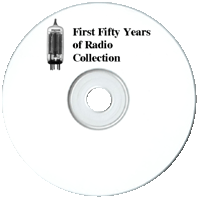

Produced for Westinghouse by KDKA on the station's 50th anniversary.

12 old time radio show recordings
(total playtime 4 hours, 59 min)
available in the following formats:
1 MP3 CD
or
6 Audio CDs
Text on OTRCAT.com ©2001-2025 OTRCAT INC All Rights Reserved. Reproduction is prohibited.

Fifty years ago, the first Old Time Radio enthusiasts were celebrating the first fifty years of radio broadcasting. For those early OTR fans, the hobby was based on discovering obscure recordings of early broadcasts, copying those recording on analog magnetic tapes, and then sharing and trading them with other OTR enthusiasts. Thankfully, most of these fragile recordings and copies have been digitally preserved and cataloged, making it easy to learn about and enjoy these broadcasts and appreciate how these early broadcasters helped to shape our modern world.

During the First World War, Westinghouse Laboratories did some developmental work for the Army Signal Corps on radio telephones. Civilian broadcasting had been curtailed during the War, and when the ban on amateur radio was lifted in 1919, Westinghouse engineer Frank Conrad began experimenting with vacuum tube sets in his spare time. His amateur station was eventually licensed and given the call letters KDKA. Conrad was instrumental in convincing Westinghouse to get into the manufacture of radio receivers for public sale. It is important to note that the earliest regular broadcasts were designed to sell radio receivers, true commercial broadcast with sponsors and ads would come later.

Pioneering radio announcer Jimmy Wallington takes up the hosting duties for the second disc. He had been there for the rise of commercial radio from the late Twenties and into the Depression years of the Thirties. Special attention is paid to the comedians who made the transition from vaudeville to radio, the power of sponsors, and the rise of radio news. Wallington takes special delight in relating how radio could regularly "scoop" print journalists.

Almost all radio was live in those days, which could lead to some interesting situations, but none seems as live as sports broadcasting. George Hamilton Combs reveals how baseball and other events were first brought to radio on disc four. The biggest objection to early sports broadcasts came from the sports team, why would fans come to the ballpark if they could hear the game on the radio? However, broadcast exposure brought an even bigger fanbase. Sports seems like a raucous lead into "black-tie" music, but radio brought classical music to millions who would have had no previous exposure to the art. As Mr. Combs points out, people who could barely afford bus fare, let alone a theater ticket, could enjoy the excitement of a Broadway show at home. Combs remembers some of the juicy scandals and events which filled the airwaves of the late Thirties, including the Lindberg Baby Story, development of the White House Press Corp, the influence of Walter Winchell, and the effect of the 1938 broadcast of The War of the Worlds.

The most chilling trend of the Thirties is the rise of Nazism in Europe. This fills the second half of disc four's second side, leading to host Gary Moore on disc five who guides us through the years of peace and the beginning of the War Years. Not only was War on the horizon, but Radio was relaxing its stand against recorded content thanks to the FCC easing regulations about identification as well as strikes by the Musician's Union. After 'the day which would live in infamy', radio spent the first year of the War bringing bad news, but what was unique was the fact that the medium continued to bring news.
KDKA Pittsburgh host Jack Bogut is our guide for the last disk. Bogut maintains that with the fiftieth anniversary of KDKA, radio is entering a second Golden Age. Acceptance of recorded music brought more power to radio disc jockeys and the increase of specialty station. Whether the rise of disc jockeys drive-time radio, rock and roll, and the voice of the youth culture constitute a Golden Age is for Twenty-first Century OTR fans to judge, but overall, the collection holds treasures for fans everywhere.
Text on OTRCAT.com ©2001-2025 OTRCAT INC All Rights Reserved. Reproduction is prohibited.
You have reached the maximum number of votes for a unregistered user.
Please login or create a new account to continue...
You have reached the maximum number to down votes in this page.



First 50 Years of Radio Disc A001
|
Add Audio CD to Cart - $5.00 |
First 50 Years of Radio Disc A002
|
Add Audio CD to Cart - $5.00 |
First 50 Years of Radio Disc A003
|
Add Audio CD to Cart - $5.00 |
First 50 Years of Radio Disc A004
|
Add Audio CD to Cart - $5.00 |
First 50 Years of Radio Disc A005
|
Add Audio CD to Cart - $5.00 |
First 50 Years of Radio Disc A006
|
Add Audio CD to Cart - $5.00 |
Please wait...
COMMENTS
Be the first to comment on "First 50 Years of Radio"
Leave a comment